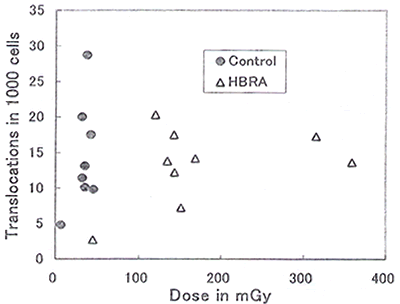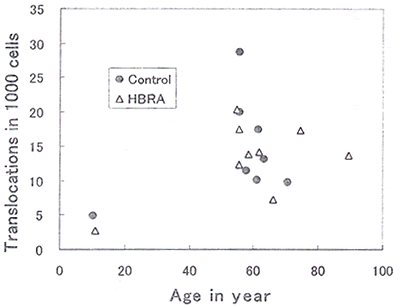|
1
|
Hansmann, I., Meyding, U. and Virsik, R. P. (1983)
X-ray induced reciprocal translocations and dicentrics in human
G0 lymphocytes. Int. J. Radiat. Biol. 43: 91-93.
|
|
2
|
Nakano, M., Nakashima,
E., Pawei, D. J., Kodama, Y. and Awa, A. (1993) Frequency of reciprocal
translocations and dicentrics induced in human blood lymphocytes
by X-irradiation as determined by fluorescence in situ hybridization.
Int. J. Radiat. Biol. 64: 565-569. |
|
3
|
Kanda, R. and Hayata,
I. (1996) Comparison of the yields of translocations and dicentrics
measured using conventional Giemsa staining and chromosome painting.
Int. J. Radiat. Biol. 69: 701-705. |
|
4
|
Jiang, T., Wang, C.-Y.,
Chen, D.-Q., Yuan, Y.-L., Wei, L.-X., Hayata, I., Morishima, H.,
Nakai, S. and Sugahara, T. (1997) Preliminary report on quantitative
study of chromosome aberrations following lifetime exposure to high
background radiation in China. In: High Levels of Natural Radiation:
Radiation Dose and Health Effects, Eds. L.-X., Wei, T. Sugahara
and Z. Tao, pp. 301-306, Elsevier Science B. V. Amsterdam. |
|
5
|
Nakai, S., Jiang, T.,
Chen, D.-Q., Hayata, I., Yuan, Y.-L., Morishima, N., Fujita, S.,
Sugahara, T. and Wei, L.-X. (1997) Effect of low dose rate on the
production of chromosome aberration under lifetime exposure to high
background radiation. ibid. pp. 307-315. |
|
6
|
Jiang, T., Hayata, I.,
Wang, C.-Y., Nakai, S., Yao, S.-Y., Yuan, Y.-L., Dai, L.-L., Liu,
Q.-G., Chen, D.-Q., Wei, L.- X. and Sugahara, T. (2000) Dose-effect
relationship of dicentric and ring chromosomes in lymphocytes of
individuals living in a high background radiation area in China.
J. Radiat. Res. 41: Suppl. 63-68. |
|
7
|
Morishima, H., Koga,
T., Tatsumi, K., Nakai, S., Sugahara, T., Yuan, Y.-G., Sun, Q.-F.
and Wei, L.-X. (1997) Study of the indirect method of personal dose
assessment for the inhabitants in HBRA of China. In: High Levels
of Natural Radiation: Radiation Dose and Health Effects, Eds. L.-X.
Wei, T. Sugahara and Z. Tao, pp. 235-24, Elsevier Science B. V.,
Amsterdam. |
|
8
|
Hayata, I., Tabuchi,
H., Furukawa, A., Okabe, N., Yamamoto, M. and Sato, K. (1992) Robot
system for preparing lymphocyte chromosome. J. Radiat. Res. 33:
Suppl. 231-241. |
|
9
|
Kanda, R., Jiang, T.,
Hayata, I. and Kobayashi, S. (1994) Effects of colcemid concentration
on chromosome aberration analysis in human lymphocytes. J. Radiat.
Res. 35: 41-47. |
|
10
|
Kanda, R. and Hayata,
I. (1998) Effect of estradiol on radiation-induced chromosome aberrations
in human lymphocytes. J. Rad. Res. 40: 95-100. |
|
11
|
Hayata, I., Sakurai,
M., Kakati, S. and Sandberg (1975) Chromosomes and causation of
human cancer and leukemia XVI. Banding studies of chronic myelocytic
leukemia, including five unusual Ph1 translocations. Cancer 36:
1177-1191. |
|
12
|
Hayata, I., Kajima, J.
and Okabe, N. (1992) Distinction of metaphases in the first cell
cycle for automated system in radiation dosimetry. Radiat. Phys.
Chem. 39: 517-520. |
|
13
|
Yamada, K., Kasama, M.
and Takai, S. (1996) Technical improvement and development for automated
detection. In: Report on Trial Researches of Nuclear Power by National
Organizatiopns, vol. 35, Eds. Ministry of Health and Welfare, pp.
118-1-118-4 (in Japanese). |
|
14
|
Hayata, I. (1993) Removal
of stainable cytoplasmic substances from cytogenetic slide preparations.
Biotechnic & Histochemistry 68: 150-152. |
|
15
|
Lucas, J. N., Awa, A.,
Straume, T., Poggensee, M., Kodama, Y., Nakano, M., Ohtaki, K.,
Weier H.-U., Pinkel, D., Gray, J. and Littlefield, G. (1992) Rapid
translocation frequency analysis in humans decades after exposure
to ionizing radiation. Int. J. Radiat. Biol. 69: 701-705. |
|
16
|
Lloyd, D. C., Edwards,
A. A., Leonard, A., Deknudt, G. L., Verschave, L., Natarajan, A.
T., Darroudi, F., Obe, G., Palitti, F., Tanzarella, C. and Tawn,
E. J. (1992) Chromosomal aberrations in human lymphocytes induced
in vitro by very low doses of X-rays. Int. J. Radiat. Biol. 61:
335-343. |
|
17
|
Pohl-Ruling, J., Fischer,
P., Haas, O., Obe, G., Natarajan, A. T., van Buul, P. P. W., Buckton,
K. E., Bianchi, N. O., Larramendy, M., Kucerova, M., Polikova, Leonard,
A., Fabry, L., Palitti, F., Sharma, T., Binder, W., Mukherjee, R.
N. and Mukherjee, U. (1983) Effect of low-dose acute X-irradiation
on the frequencies of chromosomal aberrations in human peripheral
lymphocytes. Mutat. Res. 110: 71-82. |
|
|
|
| この結果は、以下の最近の報告でも確認されている。 |
|
1
|
Zhang W, Wang C, Chen
D, Minamihisamatsu M, Morishima H, Yuan Y, Wei L, Sugahara T, Hayata
I. J Radiat Res (Tokyo). 45, 441-446, 2004. Effect of smoking on
chromosomes compared with that of radiation in the residents of
a high-background radiation area in china. |
|
2
|
Zhang W, Wang C, Chen
D, Minamihisamatsu M, Morishima H, Yuan Y, Wei L, Sugahara T, Hayata
I. J Radiat Res (Tokyo). 44, 69-74, 2003. Imperceptible effect of
radiation based on stable type chromosome aberrations accumulated
in the lymphocytes of residents in the high background radiation
area in China. |
ホームページに関するご意見・ご感想をこちらまでお寄せ下さい。
メールアドレス:rah@iips.co.jp
|

